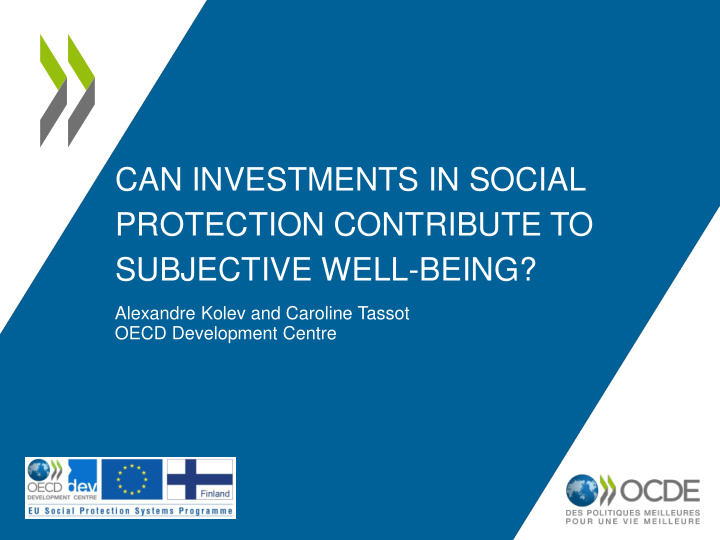



CAN INVESTMENTS IN SOCIAL PROTECTION CONTRIBUTE TO SUBJECTIVE WELL-BEING? Alexandre Kolev and Caroline Tassot OECD Development Centre
GDP as a measure of well-being …. • Even if we act to erase material poverty, there is another greater task, it is to confront the poverty of satisfaction - purpose and dignity - that afflicts us all. Too much and for too long, we seemed to have surrendered personal excellence and community values in the mere accumulation of material things. Our Gross National Product […] counts air pollution and cigarette advertising, and ambulances to clear our highways of carnage. It counts special locks for our doors and the jails for the people who break them. […] It counts napalm and counts nuclear warheads and armored cars for the police to fight the riots in our cities. […] Yet the gross national product does not allow for the health of our children, the quality of their education or the joy of their play . […] it measures everything in short, except that which makes life worthwhile. Bobby Kennedy, 1968
OECD Better Life Initiative • Are our lives getting better? • How can policies improve our lives? • Are we measuring the right things?
OECD Better Life Initiative
Subjective Well-Being (SWB) • Recognized as a reliable measure • Of interest to different audiences • Increasingly included in individual surveys • Two main different concepts: evaluative and experienced SWB
Different measures: Evaluative SWB • Refers to an overall assessment, retrospective judgment • Life Satisfaction: Please imagine a ladder, with steps numbered from 0 at the bottom to 10 at the top. The top of the ladder represents the best possible life for you and the bottom of the ladder represents the worst possible life for you. On which step of the ladder would you say you personally feel you stand at this time?
Different measures: Experienced SWB • Refers to range of emotions, positive or negative, experienced during a specific time frame • Positive index: rest, respect, smiling, learning, joy • Negative index: pain, worry, sadness, stress, anger
Macro determinants of SWB Positive Negative GDP per capita Economic downturns Political freedom Inflation Economic freedom Unemployment rate Personal freedom Generosity of unemployment benefits Labor protection legislation Rule of law Sources : Frey & Stutzer, 2002 / Di Tella, MacCulloch and Oswalk, 2003 / Veenhoven et al., 2000 / Boarini et al., 2013 / Preziosi, 2013 / Helliwell, 2005
What about social protection? • Little, sometimes problematic, evidence – Subsets of SP (unemployment benefits) – Size of state as proxy for welfare policies – Expenditures: • Weak or no correlation • Empirical and sample limitations
Relationship between social protection and subjective well-being in countries with different income levels? • Worldwide sample of 38 countries (low, middle and high income) • Experienced and evaluative well-being • Potential channels explaining this relationship
Data • ILO Social Security Expenditure Database • World Development Indicators (WDI) • SWB: Gallup World Poll (~1K/country) – Life evaluation – Positive/Negative Index
Sample 1. Afghanistan 14. El Salvador 28. Senegal 2. Bolivia 15. France 29. Slovenia 3. Bulgaria 16. Georgia 30. Spain 4. Cambodia 17. Germany 31. Sweden 5. Canada 18. Guatemala 32. Thailand 6. Central African 19. Honduras 33. Ukraine Republic 20. India 34. UK 7. Sri Lanka 21. Indonesia 35. United States of 8. Chad America 22. Ireland 9. Chile 36. Uruguay 23. Israel 10. China 37. Uzbekistan 24. Italy 11. Cyprus* 38. Yemen 25. Japan 12. Denmark 26. Jordan 13. Dominican Republic 27. Republic of Korea
SP expenditures and GDP per capita
Empirical strategy • 𝑇𝑋𝐶 𝑗𝑑𝑢 = 𝛽 + 𝛾𝑇𝑃𝐷𝑌 𝑑𝑢 + 𝛿𝑁𝑏𝑑𝑠𝑝 𝑑𝑢 + 𝜄𝑁𝑗𝑑𝑠𝑝 𝑗𝑑𝑢 + 𝜀 𝑑 + 𝜍 𝑢 + 𝜈 𝑗𝑑𝑢 • i=individual, c=country, t=time • Macro=GDP p.c., school enrolment, infant mortality, social support, generosity • Micro= age, education, marital status, gender, income, employment • Years=2009, 2010, 2011
Descriptive statistics
Results • Positive statistically significant relationship between social expenditures and subjective well-being (both evaluative and experienced)
Does it differ for the rich/poor? • Identify effect for bottom 40% versus top 60% • The relationship is stronger between subjective well-being and SP for the bottom 40%, but it matters to everyone
Does it differ for beneficiaries/non beneficiaries? • Use subset of child related SP expenditures and the effect on individuals with children • The difference is very small
Robustness test • Check if SP expenditures are a good proxy for social protection • Check if enrolment/generosity have different effects use World Bank ASPIRE data on social protection enrolment (CCTs) and SWB data from LatinoBarometro Results hold!
Conclusions • Positive significant robust relationship between SWB and SP • Effect is stronger for the poor • Relationship partially driven by « direct effect » , but also potential altuistic mechanism, general benefit to overall population
Questions?
Recommend
More recommend